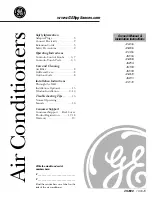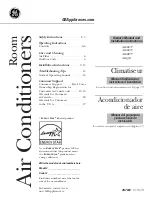
31
3P362438-1B English
Perform the test procedure as described in 15.4.2. Test operation on
page 38.
INFORMATION
•
When a malfunction is detected during the procedure (e.g., in case
of closed stop valve), a malfunction code will be displayed. In that
case, refer to 15.5. Malfunction code list on page 39 and solve
the malfunction accordingly. Resetting the malfunction can be done
by pushing BS3. The procedure can be restarted from 6B).
•
Aborting the manual refrigerant charge is possible by pushing BS3.
The unit will stop and return to idle condition.
Information which may occur during additional refrigerant charging
procedures:
P8: Indoor unit freeze up prevention
Action:
Close valve A immediately. Reset malfunction by pushing
BS1. Retry auto charge procedure.
P2: Abnormal low pressure drop
Action:
Close valve A immediately. Reset malfunction by pushing
BS1. Check following items before retry auto charge procedure:
- Check if the gas side stop valve is opened correctly.
- Check if the valve of the refrigerant cylinder is opened.
- Check if the air inlet and outlet of the indoor units are not ob-
structed.
E-2
:
Indoor temperature is out of range.
E-3
:
Outdoor temperature is out of range.
E-5
: An indoor unit which is not compatible with automatic refrigerant
charge functionality is installed (e.g., Mini-split indoor unit, etc.)
Other malfunction code: close valve A immediately. Confirm the mal
-
function code and take corresponding action, 15.5. Malfunction code
list on page 39.
14 .3 .3 . Final charge adjustment
It is not necessary to do this final adjustment normally, but perform the
following operation only when if the most adequate refrigerant for the
best performance is required.
The outdoor temperature must be between 60°F (16°C) and 97°F
(36 °C).
Purge gauge lines. Connect service gauge manifold to the service
port between the compressor and the reversing valve in each outdoor
unit. Run the system for 30 minutes in cooling by the forced operation
using the field setting mode [2-6] (value 0: OFF, 1:ON) (Refer to 15.2.
Monitoring function and field settings.) to allow pressures to stabilize,
then check subcooling as detailed in the following sections.
Subcooling = Sat. Liquid Temp. – Liquid Line Temp.
1
Temporarily install a thermometer on the liquid line between the
coil and the EV in each outdoor unit. Ensure the thermometer
makes adequate contact and is insulated for best possible read-
ings. Use liquid line temperature to determine sub cooling.
2
Check subcooling for each outdoor unit and calculate the average
subcooling of the outdoor unit. Systems should have a subcooling
of 11±3°F (6±2°C).
a. If average subcooling is low, add charge to raise subcooling to
11±3°F (6±2°C) (The maximum additional charge is 4.4 lbs.
(2kg))
b. If average subcooling is high, remove charge to lower the sub-
cooling to 11±3°F (6±2°C)
14 .3 .4 . Checks after adding refrigerant
•
Are the stop valves for liquid and gas open?
•
Is the amount of refrigerant, that has been added, recorded on the
refrigerant charge label?
NOTE
Make sure to open all stop valves after (pre-) charging the refrigerant.
Operating with the stop valves closed will damage the compressor.
15 .
Start-up and configuration
INFORMATION
It is important that all information in this chapter is read sequentially by
the installer and that the system is configured as applicable.
DANGER: ElECTRICAl SHOCk
See Safety considerations on page i.
15 .1 . Checks before initial start up
After the installation of the unit, first check the following items. Once all
below checks are fulfilled, the unit must be closed, only then can the
unit be powered up.
1
Installation
Check that the unit is properly installed, to avoid abnormal noises
and vibrations when starting up the unit.
















































